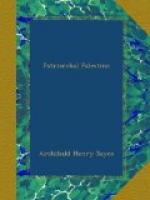The discovery of the site of Kadesh-barnea is due in the first instance to Dr. Rowlands, secondly to the archaeological skill of Dr. Clay Trumbull. It is still known as ’Ain Qadis, “the spring of Qadis,” and lies hidden within the block of mountains which rise in the southern desert about midway between Mount Seir and the Mediterranean Sea. The water still gushes out of the rock, fresh and clear, and nourishes the oasis that surrounds it. It has been marked out by nature to be a meeting-place and “sanctuary” of the desert tribes. Its central position, its security from sudden attack, and its abundant supply of water all combined to make it the En-Mishpat or “Spring of Judgment,” where cases were tried and laws enacted. It was here that the Israelites lingered year after year during their wanderings in the wilderness, and it was from hence that the spies were sent out to explore the Promised Land. In those days the mountains which encircled it were known as “the mountains of the Amorites” (Deut. i. 19, 20). In the age of the Babylonian invasion, however, the Amorites had not advanced so far to the south. They were as yet only at Hazezon-tamar, the “palm-grove” on the western shore of the Dead Sea, which a later generation called En-gedi (2 Chron. xx. 2). En-Mishpat was still in the hands of the Amalekites, the lords of “all the country” round about.
The Amalekites had not as yet intermingled with the Ishmaelites, and their Beduin blood was still pure. They were the Shasu or “Plunderers” of the Egyptian inscriptions, sometimes also termed the Sitti, the Sute of the cuneiform texts. Like their modern descendants, they lived by the plunder of their more peaceful neighbours. As was prophesied of Ishmael, so could it have been prophesied of the Amalekites, that their “hand should be against every man, and every man’s hand against” them. They were the wild offspring of the wilderness, and accounted the first-born of mankind (Numb. xxiv. 20).
From En-Mishpat the Babylonian forces marched northward along the western edge of the Dead Sea. Leaving Jerusalem on their left, they descended into the vale of Siddim, where they found themselves in the valley of the Jordan, and consequently in the land of the Canaanites. As we are told in the Book of Numbers (xiii. 29), while “the Amalekites dwell in the land of the south, and the Hittites and the Jebusites and Amorites dwell in the mountains, the Canaanites dwell by the sea and by the coast of Jordan.”
The word Canaan, as we have seen, meant “the lowlands,” and appears sometimes in a longer, sometimes in a shorter form. The shorter form is written Khna by the Greeks: in the Tel el-Amarna tablets it is Kinakhkhi, while Canaan, the longer form, is Kinakhna. It is this longer form which alone appears in the hieroglyphic texts. Here we read how Seti I. destroyed the Shasu or Amalekites from the eastern frontier of Egypt to “the land of Kana’an,” and captured their fortress




